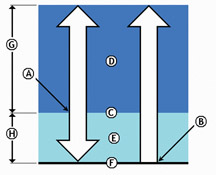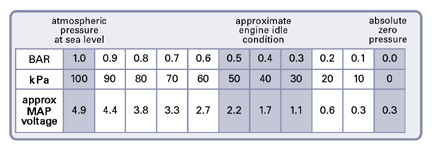The next question, though, would stump most.
What is absolute pressure?
In absolute measurement, the zero point (where the measuring device indicates zero) is an absolute zero pressure. That means no pressure, or in other words, a 100% vacuum.
The pressure gauges I have indicate zero when no pressure is being measured. Isn't this absolute zero?
No. Most pressure or vacuum gauges indicate zero pressure when not connected, or when there is no pressure or vacuum being measured. However, there actually is pressure -- the atmospheric pressure that surrounds the earth.
You mean barometric pressure?
Yes, even though your pressure or vacuum gauge may indicate zero, the atmospheric or barometric pressure is always present. Conventional gauges always measure gauge pressure.
What is gauge pressure?
Gauge pressure has its zero point at the current barometric pressure (fig. 17). Everything above barometric pressure is called pressure and everything below barometric pressure is called vacuum.
A - Gauge Pressure Zero indicated here
B - Absolute Pressure Zero indicated here
C - Current barometric pressure
D - Atmospheric Pressure
E - Vacuum
F - Perfect Vacuum
G - Operating Range of Standard Pressure Gauge
H - Operating Range of Standard Vacuum Gauge
Conventional pressure or vacuum gauges are constructed to measure gauge pressure to keep the cost affordable.
An absolute pressure gauge is bulky and expensive. Laboratory-grade devices that measure absolute pressure cost over $1000.
Tell me about atmospheric, or barometric, pressure.
The two terms are interchangeable. Atmospheric pressure at sea level on a standard day is approximately 14.7 pounds per square inch (psi), or 29.9 inches of mercury (HG), or 101 kilopascals (kPa), or 1 Bar.
These various standards differ only in the units of measure used to express them.
Does atmospheric pressure always stay the same?
No. Two factors can make the atmospheric pressure vary. First, at an altitude above sea level the atmospheric pressure goes down, because the density of the air goes down.
Second, weather or climate can change the atmospheric pressure -- high pressure or low pressure days. This is why the standard sea level atmospheric pressure is listed as being on a standard day.
How do my conventional pressure or vacuum gauges act at various altitudes?
They react the same at high altitude as at sea level, which is exactly the point we are getting to.
Conventional pressure gauges have no way to compensate for different altitudes or weather changes. They will indicate zero either at sea level or at the top of a mountain. However, the atmospheric pressure is certainly different at these two extremes.
Why is this atmospheric pressure measurement so important?
The air in the atmosphere contains oxygen. An engine burns a mixture of oxygen and fuel. For an engine to burn efficiently, it has to have just the right mixture of fuel and oxygen.
To determine the correct air/fuel mixture and the correct ignition timing, the PCM must know the atmospheric (BARO) pressure. If the PCM is to compensate for changes in altitude or weather, it must have an input signal that reflects these changes in atmospheric pressure.
The Manifold Absolute Pressure sensor does this?
Yes. And, on engines that do not have a Mass Air Flow (MAF) sensor, the MAP sensor signal is also used by the PCM to calculate engine load -- how hard the engine is working. This is called the speed-density method of calculating engine load for engines without MAF sensors. It is because of this engine load calculation for speed-density engines that the accuracy of the MAP sensor signal is so critical.
On OBD-II engines, the MAP sensor signal is also used for EGR diagnosis.
What are the normal ranges of the sensor's output voltage?
The most common MAP sensor generates an output voltage between 0 and 5 volts, depending on the pressure being measured. It must be able to measure atmospheric pressure at the lowest elevations, which in some areas is slightly below sea level. The standard atmospheric pressure at sea level is about 101 kPa. In the Death Valley, Utah, which is below sea level, the atmospheric pressure can be higher than 101 kPa. At the top of Pikes Peak mountain in Colorado, which is more than 14,000 (4,267 m) feet above sea level, the baro pressure is less than 65 kPa. So, the MAP sensor must have a measurement range of 105 kPa to about 15 kPa.
How does the MAP sensor measure pressure UP from absolute zero?
Imagine two glass jars glued together at the open ends, with a flexible membrane sealed between them. Drill a hole into the bottom of each jar, and glue a tube into each hole. Now, connect a powerful vacuum pump to one of the tubes.
When the vacuum pump removes ALL the atmospheric pressure from the jar, seal the tube, trapping the vacuum in the jar. The flexible membrane will be pushed in towards the vacuum chamber jar by the atmospheric pressure in the open jar.
The vacuum jar has absolutely no pressure in it, so it becomes the absolute zero reference point.
Any pressure on the atmospheric side will push the flexible membrane in, but higher pressure will push it in further.
Remember, high pressure in this case equals atmospheric pressure, about 101 kPa at sea level.
Now, attach a hose from the intake manifold of your engine to the open jar. Devise an electrical circuit to measure how far the membrane flexes, and you have the basic idea of how a MAP sensor works (fig. 18).
A - Hose fitting to manifold
B - Thin silicon diaphragm
C - Reference pressure chamber (Absolute vacuum, zero pressure)
D - Pyrex glass
E - Sensing resistors on silicon diaphragm
When would I ever measure a reading as low as 15 kPa?
The sensor is called a manifold absolute pressure sensor because its sensing element is connected to the intake manifold, either through a hose or a direct mount. When the engine is not running, the pressure inside the intake manifold is equal to atmospheric pressure, and the PCM will use this "engine not running" MAP signal as the BARO reading.
A running engine acts like a large vacuum pump. When the throttle is nearly shut, the pressure in the intake manifold is very low -- as low as 15 kPa at a high-speed, closed-throttle deceleration. As the throttle is opened, the pressure inside the intake manifold increases because the atmospheric pressure outside the intake manifold is rushing in, limited only by the engine's throttle blade opening.
The accompanying chart shows that low manifold pressure (engine idling) equals low MAP output voltage, and high pressure (engine at WOT or not running at all) equals high MAP output voltage.
What is the function of the three wires leading to the MAP sensor?
One of the wires provides a precise 5 volt power supply from the PCM. Another wire provides the ground circuit, grounded only through the PCM. The third is the signal wire, carrying the signal voltage generated by the MAP sensor to the PCM.
- Thanks to Jack Woodward

figure 17

figure 18

